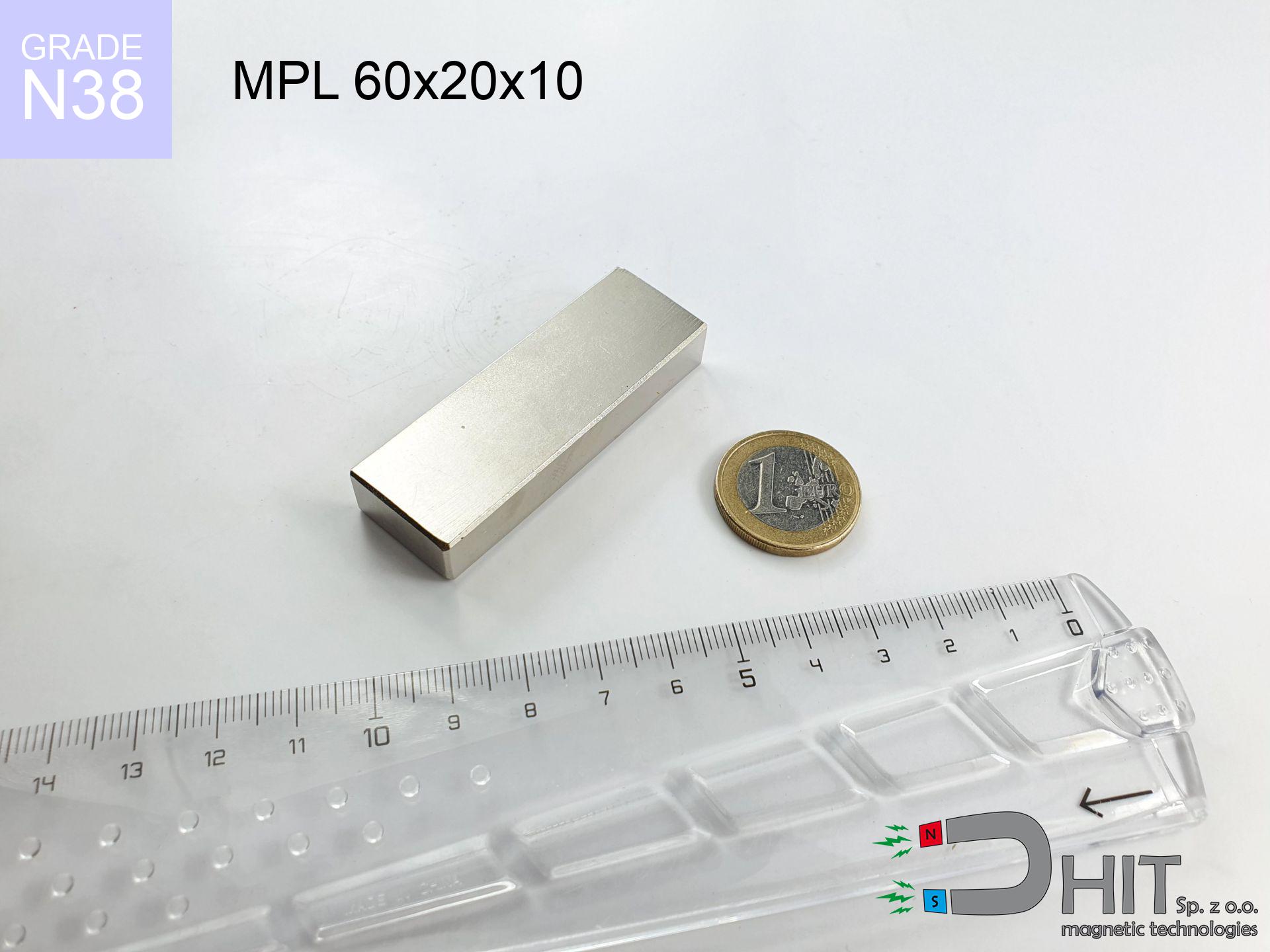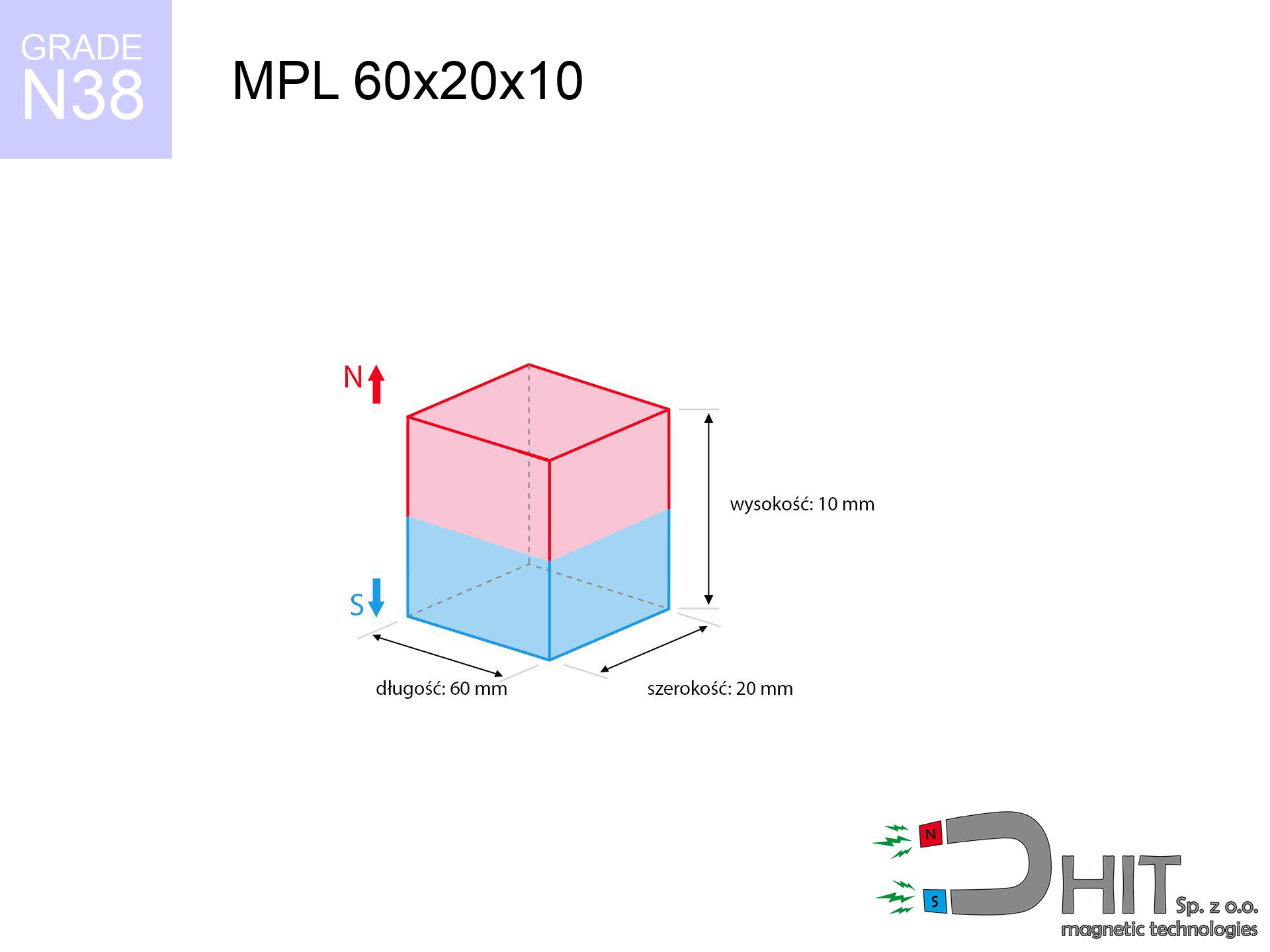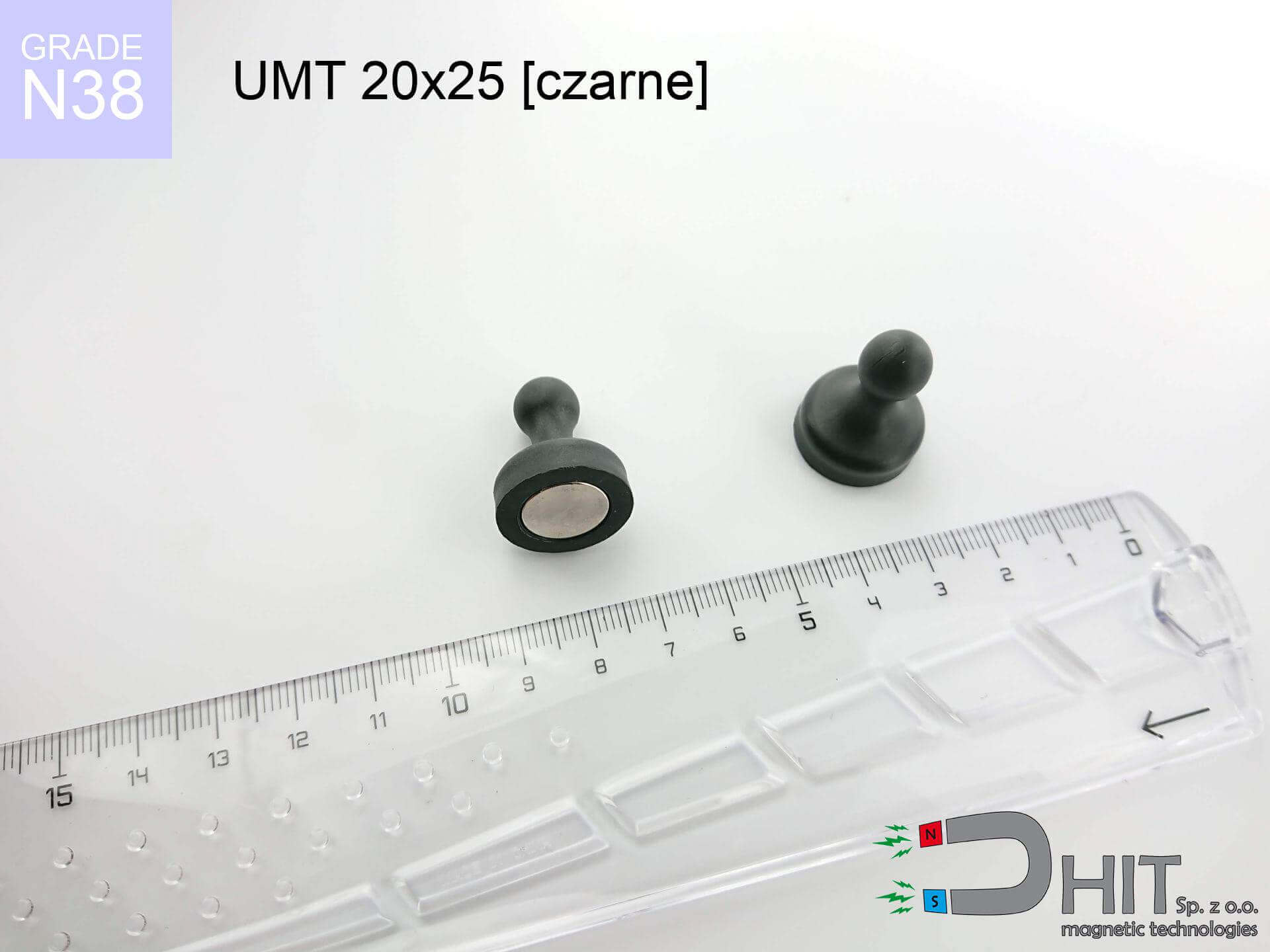MPL 60x20x10 / N38 - lamellar magnet
lamellar magnet
Catalog no 020174
GTIN: 5906301811800
length
60 mm [±0,1 mm]
Width
20 mm [±0,1 mm]
Height
10 mm [±0,1 mm]
Weight
90 g
Magnetization Direction
↑ axial
Load capacity
20.1 kg / 197.17 N
Magnetic Induction
329.64 mT
Coating
[NiCuNi] Nickel
68.27 ZŁ with VAT / pcs + price for transport
55.50 ZŁ net + 23% VAT / pcs
bulk discounts:
Need more?Need help making a decision?
Give us a call
+48 22 499 98 98
or send us a note via
form
through our site.
Force along with appearance of magnetic components can be reviewed with our
power calculator.
Same-day shipping for orders placed before 14:00.
MPL 60x20x10 / N38 - lamellar magnet
Specification / characteristics MPL 60x20x10 / N38 - lamellar magnet
| properties | values |
|---|---|
| Cat. no. | 020174 |
| GTIN | 5906301811800 |
| Production/Distribution | Dhit sp. z o.o. |
| Country of origin | Poland / China / Germany |
| Customs code | 85059029 |
| length | 60 mm [±0,1 mm] |
| Width | 20 mm [±0,1 mm] |
| Height | 10 mm [±0,1 mm] |
| Weight | 90 g |
| Magnetization Direction | ↑ axial |
| Load capacity ~ ? | 20.1 kg / 197.17 N |
| Magnetic Induction ~ ? | 329.64 mT |
| Coating | [NiCuNi] Nickel |
| Manufacturing Tolerance | ±0.1 mm |
Magnetic properties of material N38
| properties | values | units |
|---|---|---|
| remenance Br [Min. - Max.] ? | 12.2-12.6 | kGs |
| remenance Br [Min. - Max.] ? | 1220-1260 | T |
| coercivity bHc ? | 10.8-11.5 | kOe |
| coercivity bHc ? | 860-915 | kA/m |
| actual internal force iHc | ≥ 12 | kOe |
| actual internal force iHc | ≥ 955 | kA/m |
| energy density [Min. - Max.] ? | 36-38 | BH max MGOe |
| energy density [Min. - Max.] ? | 287-303 | BH max KJ/m |
| max. temperature ? | ≤ 80 | °C |
Physical properties of sintered neodymium magnets Nd2Fe14B at 20°C
| properties | values | units |
|---|---|---|
| Vickers hardness | ≥550 | Hv |
| Density | ≥7.4 | g/cm3 |
| Curie Temperature TC | 312 - 380 | °C |
| Curie Temperature TF | 593 - 716 | °F |
| Specific resistance | 150 | μΩ⋅Cm |
| Bending strength | 250 | Mpa |
| Compressive strength | 1000~1100 | Mpa |
| Thermal expansion parallel (∥) to orientation (M) | (3-4) x 106 | °C-1 |
| Thermal expansion perpendicular (⊥) to orientation (M) | -(1-3) x 10-6 | °C-1 |
| Young's modulus | 1.7 x 104 | kg/mm² |
Technical analysis of the magnet - data
These values are the result of a engineering analysis. Results are based on algorithms for the NdFeB class. Actual parameters might slightly deviate from the simulation. Please consider these data as a guide for designers.
MPL 60x20x10 / N38
| Distance (mm) | Induction (Gauss) / mT | Pull Force (kg) | Risk Status |
|---|---|---|---|
| 0 mm |
4449 Gs
444.9 mT
|
20.10 kg / 20100.0 g
197.2 N
|
dangerous! |
| 1 mm |
4168 Gs
416.8 mT
|
17.64 kg / 17638.0 g
173.0 N
|
dangerous! |
| 2 mm |
3869 Gs
386.9 mT
|
15.20 kg / 15200.2 g
149.1 N
|
dangerous! |
| 5 mm |
2216 Gs
221.6 mT
|
4.99 kg / 4987.4 g
48.9 N
|
strong |
| 10 mm |
1397 Gs
139.7 mT
|
1.98 kg / 1982.9 g
19.5 N
|
low risk |
| 15 mm |
907 Gs
90.7 mT
|
0.84 kg / 835.5 g
8.2 N
|
low risk |
| 20 mm |
615 Gs
61.5 mT
|
0.38 kg / 383.8 g
3.8 N
|
low risk |
| 30 mm |
314 Gs
31.4 mT
|
0.10 kg / 99.9 g
1.0 N
|
low risk |
| 50 mm |
108 Gs
10.8 mT
|
0.01 kg / 12.0 g
0.1 N
|
low risk |
MPL 60x20x10 / N38
| Surface Type | Friction Coefficient / % Mocy | Max Load (kg) |
|---|---|---|
| Raw steel |
µ = 0.3
30% Nominalnej Siły
|
6.03 kg / 6030.0 g
59.2 N
|
| Painted steel (standard) |
µ = 0.2
20% Nominalnej Siły
|
4.02 kg / 4020.0 g
39.4 N
|
| Oily/slippery steel |
µ = 0.1
10% Nominalnej Siły
|
2.01 kg / 2010.0 g
19.7 N
|
| Magnet with anti-slip rubber |
µ = 0.5
50% Nominalnej Siły
|
10.05 kg / 10050.0 g
98.6 N
|
MPL 60x20x10 / N38
| Steel Thickness (mm) | % Power | Real Pull (kg) |
|---|---|---|
| 0.5 mm |
|
1.01 kg / 1005.0 g
9.9 N
|
| 1 mm |
|
2.51 kg / 2512.5 g
24.6 N
|
| 2 mm |
|
5.03 kg / 5025.0 g
49.3 N
|
| 5 mm |
|
12.56 kg / 12562.5 g
123.2 N
|
| 10 mm |
|
20.10 kg / 20100.0 g
197.2 N
|
MPL 60x20x10 / N38
| Ambient Temp. (°C) | Power Loss | Remaining Pull | Status |
|---|---|---|---|
| 20 °C | 0.0% |
20.10 kg / 20100.0 g
197.2 N
|
OK |
| 40 °C | -2.2% |
19.66 kg / 19657.8 g
192.8 N
|
OK |
| 60 °C | -4.4% |
19.22 kg / 19215.6 g
188.5 N
|
OK |
| 80 °C | -6.6% |
18.77 kg / 18773.4 g
184.2 N
|
|
| 100 °C | -28.8% |
14.31 kg / 14311.2 g
140.4 N
|
MPL 60x20x10 / N38
| Gap (mm) | Attraction (kg) (N-S) | Repulsion (kg) (N-N) |
|---|---|---|
| 0 mm |
30.15 kg / 30150.0 g
295.8 N
|
N/A |
| 2 mm |
22.80 kg / 22800.0 g
223.7 N
|
21.28 kg / 21280.0 g
208.8 N
|
| 5 mm |
7.49 kg / 7485.0 g
73.4 N
|
6.99 kg / 6986.0 g
68.5 N
|
| 10 mm |
2.97 kg / 2970.0 g
29.1 N
|
2.77 kg / 2772.0 g
27.2 N
|
| 20 mm |
0.57 kg / 570.0 g
5.6 N
|
0.53 kg / 532.0 g
5.2 N
|
| 50 mm |
0.02 kg / 15.0 g
0.1 N
|
0.01 kg / 14.0 g
0.1 N
|
MPL 60x20x10 / N38
| Object / Device | Limit (Gauss) / mT | Safe distance |
|---|---|---|
| Pacemaker | 5 Gs (0.5 mT) | 16.5 cm |
| Hearing aid / Implant | 10 Gs (1.0 mT) | 13.0 cm |
| Mechanical watch | 20 Gs (2.0 mT) | 10.0 cm |
| Phone / Smartphone | 40 Gs (4.0 mT) | 8.0 cm |
| Car key | 50 Gs (5.0 mT) | 7.0 cm |
| Payment card | 400 Gs (40.0 mT) | 3.0 cm |
| HDD hard drive | 600 Gs (60.0 mT) | 2.5 cm |
MPL 60x20x10 / N38
| Start from (mm) | Speed (km/h) | Energy (J) | Predicted outcome |
|---|---|---|---|
| 10 mm |
15.97 km/h
(4.44 m/s)
|
0.89 J | |
| 30 mm |
26.19 km/h
(7.27 m/s)
|
2.38 J | |
| 50 mm |
33.71 km/h
(9.36 m/s)
|
3.95 J | |
| 100 mm |
47.66 km/h
(13.24 m/s)
|
7.89 J |
MPL 60x20x10 / N38
| Technical parameter | Value / Description |
|---|---|
| Coating type | [NiCuNi] Nickel |
| Layer structure | Nickel - Copper - Nickel |
| Layer thickness | 10-20 µm |
| Salt spray test (SST) ? | 24 h |
| Recommended environment | Indoors only (dry) |
MPL 60x20x10 / N38
| Environment | Effective Steel Pull | Effect |
|---|---|---|
| Air (Land) | 20.10 kg | Standard |
| Water (Riverbed) |
23.01 kg
(+2.91 kg Buoyancy gain)
|
+14.5% |
Other products
Pros as well as cons of neodymium magnets.
In addition to their magnetic efficiency, neodymium magnets provide the following advantages:
- They virtually do not lose strength, because even after 10 years the performance loss is only ~1% (according to literature),
- They do not lose their magnetic properties even under close interference source,
- The use of an elegant coating of noble metals (nickel, gold, silver) causes the element to have aesthetics,
- The surface of neodymium magnets generates a intense magnetic field – this is a key feature,
- Made from properly selected components, these magnets show impressive resistance to high heat, enabling them to function (depending on their shape) at temperatures up to 230°C and above...
- Thanks to the ability of free shaping and customization to unique projects, neodymium magnets can be modeled in a wide range of geometric configurations, which increases their versatility,
- Wide application in innovative solutions – they are utilized in computer drives, drive modules, medical equipment, also complex engineering applications.
- Thanks to efficiency per cm³, small magnets offer high operating force, with minimal size,
Characteristics of disadvantages of neodymium magnets and ways of using them
- At strong impacts they can break, therefore we recommend placing them in special holders. A metal housing provides additional protection against damage, as well as increases the magnet's durability.
- We warn that neodymium magnets can lose their power at high temperatures. To prevent this, we recommend our specialized [AH] magnets, which work effectively even at 230°C.
- When exposed to humidity, magnets usually rust. For applications outside, it is recommended to use protective magnets, such as magnets in rubber or plastics, which secure oxidation as well as corrosion.
- We suggest casing - magnetic holder, due to difficulties in producing threads inside the magnet and complicated forms.
- Possible danger related to microscopic parts of magnets pose a threat, in case of ingestion, which is particularly important in the aspect of protecting the youngest. Furthermore, small elements of these devices can complicate diagnosis medical after entering the body.
- With mass production the cost of neodymium magnets is a challenge,
Maximum lifting force for a neodymium magnet – what contributes to it?
The load parameter shown refers to the maximum value, obtained under ideal test conditions, namely:
- on a base made of structural steel, optimally conducting the magnetic flux
- whose transverse dimension reaches at least 10 mm
- with a surface perfectly flat
- under conditions of ideal adhesion (metal-to-metal)
- under perpendicular force direction (90-degree angle)
- at ambient temperature room level
Lifting capacity in real conditions – factors
Real force impacted by working environment parameters, mainly (from priority):
- Clearance – the presence of any layer (paint, dirt, gap) acts as an insulator, which lowers capacity rapidly (even by 50% at 0.5 mm).
- Loading method – catalog parameter refers to detachment vertically. When slipping, the magnet holds much less (typically approx. 20-30% of nominal force).
- Plate thickness – too thin steel does not accept the full field, causing part of the flux to be wasted to the other side.
- Plate material – mild steel gives the best results. Alloy steels decrease magnetic properties and lifting capacity.
- Smoothness – full contact is obtained only on polished steel. Any scratches and bumps reduce the real contact area, weakening the magnet.
- Heat – NdFeB sinters have a negative temperature coefficient. At higher temperatures they lose power, and at low temperatures gain strength (up to a certain limit).
* Lifting capacity was assessed with the use of a smooth steel plate of suitable thickness (min. 20 mm), under perpendicular pulling force, however under parallel forces the holding force is lower. Moreover, even a small distance {between} the magnet and the plate decreases the load capacity.
Safe handling of NdFeB magnets
Crushing force
Large magnets can smash fingers instantly. Never put your hand between two attracting surfaces.
Mechanical processing
Fire hazard: Rare earth powder is explosive. Do not process magnets in home conditions as this may cause fire.
GPS and phone interference
Remember: rare earth magnets generate a field that interferes with precision electronics. Keep a safe distance from your phone, tablet, and GPS.
Data carriers
Powerful magnetic fields can erase data on payment cards, hard drives, and other magnetic media. Stay away of at least 10 cm.
Heat warning
Avoid heat. NdFeB magnets are sensitive to heat. If you require resistance above 80°C, ask us about HT versions (H, SH, UH).
Life threat
People with a pacemaker have to keep an large gap from magnets. The magnetic field can interfere with the functioning of the implant.
Swallowing risk
Only for adults. Tiny parts can be swallowed, causing severe trauma. Keep away from children and animals.
Protective goggles
NdFeB magnets are ceramic materials, meaning they are fragile like glass. Clashing of two magnets leads to them breaking into shards.
Handling guide
Be careful. Rare earth magnets attract from a long distance and snap with massive power, often quicker than you can react.
Metal Allergy
It is widely known that nickel (the usual finish) is a common allergen. If your skin reacts to metals, refrain from touching magnets with bare hands or choose versions in plastic housing.
Warning!
Details about hazards in the article: Magnet Safety Guide.







![UMP 75x25 [M10x3] GW F200 GOLD DUAL / N42 - search holder UMP 75x25 [M10x3] GW F200 GOLD DUAL / N42 - search holder](https://cdn3.dhit.pl/graphics/products/ump-75x25-m10x3-gw-f200-gold-dual-xoc.jpg)

